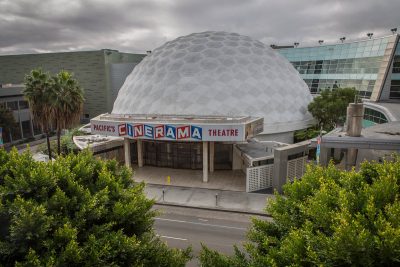
Saturday December 1st the Visual Effects Society (VES) held a panel discussion titled “Understanding Unions: The Good, The Bad & Unknown Of Forming A Visual Effects Collective Bargaining Organization”.
The event was held at the Los Angeles Film School on Sunset Boulevard in Hollywood, across the street from the famous Cinerama Dome Theatre. A couple of blocks away a restaurant was being used as a location for a large shoot, mobile dressing rooms, large grip trucks, a lot of crew scurrying about. The location served to highlight the focus of the meeting, the importance of the film business to Los Angeles.
Jeff Okun, VES Chair, started things off explaining that the event was organized by the VES Business, Labor and Law committee, which was formed because “we found over our history that visual effects practitioners are artists, not businessmen…”
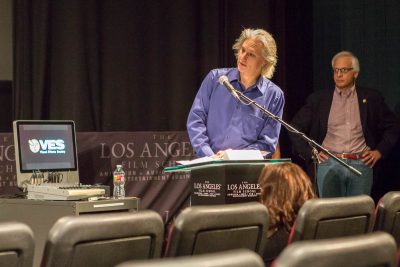
Okun continued that the VES is neutral on the subject of a union as they are an international society and it is a North American issue. The crowd was smaller than the Film School’s theatre could hold, a bit disappointing. As usual with these kinds of events there was great discussions going on before and after the event. A lot of passion about the health of the visual effects business was clear.
Marty Shindler (CEO,The Shindler Perspective – www.ishindler.com) led the discussion, Okun introduced him as having a background that includes working as an executive at Fox, ILM, Cinesite and Bank of America. Shindler then introduced the panel made up of:
– Scott Dougherty – Executive Producer / Co-Owner, Furious FX, Inc.
– Steven J Kaplan – Organizer for The Animation Guild, Local 839 IATSE
– John Parentau – Most recently was General Manager, Pixomondo L.A.
– Ellen Shadur – Attorney at Baker Hostetler – www.bakerlaw.com/ellenjshadur
– Bill Taylor, ASC, VES
Getting Started
There was quite a lot of setup and definitions, getting a feel for the makeup of the audience, and just getting things rolling. As the audience had spent at least a half hour before the session talking to each other in the lobby, this part was unfortunately a bit slow. A trend we have observed at conferences is that most people today know why they are there and have at least read the brief on the web before arriving. Twitter quickly becomes a barometer during any event, by a half hour into the session an active side commentary was running on twitter.
Shindler asked why were were all here today – why is this a topic today instead of yesterday, five years ago or even twenty years ago? Steve Kaplan weighed in: “I would say, having worked as a visual effects artist some twenty years ago, that this was a topic then, and is a topic now. Historically things come to a head because conditions continue to get worse and worse and people want to find a way to change things. I think a union with a Trade Organization is the best way to do that. This is a natural progression and can be seen throughout history in many different fields”. John Parentau added “… some way that we, not only as company owners but also as artists band together to have some voice, that’s really crucial, more so now, than ever.” The topic of a Trade Association would be a recurring topic throughout the day.
Runaway Production and unions
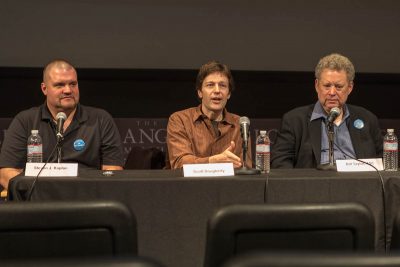
Moving on to runaway production, work chasing tax incentives in other states or countries, Shindler asked: “how would, if at all, the formation of a union impact or help prevent runaway production?”. Kaplan: “… while there may be a cost associated with signing a union contract in the sense that the union would typically bargain in health and pension contributions or give themselves the ability to enforce state and federal labor laws that includes things like overtime pay, it really is an apples to apples comparison… if participation in the Motion Picture Industry Pension and Health plan requires $8 an hour per employee, what are you currently spending on your health coverage? Were you aware that the IA’s National Benefit fund can be a lower cost option to offer health care to your employees? So would the cost of unionization be a factor?, possibly, but the IA has a long history of being able to tailor contracts to the needs of specific productions, studios, and specifically visual effects facilities”. Getting more specific to the runaway question Kaplan continued: “the tax incentives while certainly an incentive toward the production companies are not an incentive toward the visual effects shops, and not an incentive toward the artists.” Kaplan continued: “Would unionization bring further.. (runaway production)… unionization would only bring a voice to the artists to contribute to standards and conditions in the workplace here and in Canada where the IA has jurisdiction. Runaway production is going to exist as long as people in the locales vote it in. I don’t see how unionization is going to either exacerbate that or staunch that from happening “.
Bill Taylor told the group that his former company, Illusion Arts, was a union shop and he felt that that allowed them to attract top artists and made the negotiation process very straight forward. He added “in terms of cost we didn’t have a single person working for us who worked at union scale, everyone was above union scale… the cost impact on us was trivial to none.” He added that the union did audit them every couple of years but felt that that was part of doing business and that overall it was a plus for them.
Ellen Shadur said that in her opinion there is a cost to unionizing, time spent negotiating, dealing with grievances, etc., she suggested that it could add another 15-20% to the employers cost. Kaplan came back to this point later in the day to say that “words are important and that yes while there would be costs involved in unionization but I think this 15% figure is a bit high… certainly things like grievance procedures would be written into a visual effects contract,like they are into any contract, but the cost analysis needs to be done before figures like that can be thrown around.”
Speaking about the trade association/union issue Bill Taylor said that neither can be dealt with in a vacuum, that all these steps need to be taken but that somebody has to go first and take the first step. Kaplan added “the ultimate goal is to form a union for artists and a trade association for the visual effects facilities, so that together we can go to what I call the Producers, those who bargain with the AMPTP (Alliance of Motion Picture and Television Producers -http://www.amptp.org) and say ‘look, more money needs to flow this way’ “.
A Mighty Force and Fairness
Bill Taylor talked about a title card in the end credits of “The Life of Pi”, that the film had employed 1400 artists and technicians and 600,000 man hours… adding “we are potentially, internationally, a mighty force, and it’s time to recognize that.” “We have made it seem like what we do is easy, it is not. We have made it seem like we are interchangeable and we are not”.
Scott Dougherty said that as a small business owner he can say that margins are non existent, companies struggle to cover their costs. “We ask people to come up with a salary that they are comfortable with… you’ll get this every week, knowing that there are weeks there will be weekend work, there are weeks there will be late nights, but there will be days when you take half a day to go to your daughters recital, there is flexibility when you come in… we offer flexibility that a lot of larger companies don’t offer. We are a smaller company, we also don’t offer overtime, double time and other things like that”. There was an unease in the crowd where we sat as Dougherty explained this because California labor law is very strict about such things and Dougherty was describing a serious lack of understanding of these laws.
Dougherty later spoke about fairness and treating artists and clients fairly. Kaplan came back to this topic later: “My boss has taught me something about the word ‘fair’, it’s the beginning of ‘fairy tale’. There is no fair in this world and as much as I mean that to be funny there is leverage, and that’s it.” “While I believe that Furious FX and Scott’s company would benefit from being a union studio I would think that certain things he’s mentioned would have to be addressed… flat weekly rates without overtime, that’s against labor laws so we would certainly want to address that. But we would not be so heavy handed as to say you’re going to do this and not going to do this, and good luck. We would certainly work with Scott and with Furious on not only being able to support the artistic staff but also to do so by following the law.”
Continuing on the fairness topic, Dougherty: “We’re talking about fairness and we put the studios into the same sentence. They don’t care about fairness, they want to make money. They don’t care as individuals or companies if we complain we are not making enough money, they’ll just go to another company. Until we all band together as companies and people and say to the studios ‘no’, or turn down that job because it doesn’t pay enough – someone else is going to take the job.”
A theme that came up a few times was that the Producers have a duty to produce the best possible work for the lowest possible price. But there were several examples given of conditions – like staffing up for a show and then being surprised by the studio with a three month delay on turnover of plates. Parentau: “there are so many situations like that because we have no strength as a unit to be able to say to the studios… some sort of language that says if you delay your plate delivery, you have to pay us x amount of dollars every week…”. The point was made again about the power of many, rather than the weakness of the individual, in this case referring to the vfx facilities and a Trade Association.
Kaplan made a very important comparison to live action, a wholly unionized part of the business saying “I honestly shudder to think what live action production would look like today if it had not been unionized for quite a long time. I think introducing a union to the visual effects industry will see all boats rise, because that is historically what unions do”. Shadur came back to this later in the day to say that human beings are involved and that she has seen this not always be the case, that there are usually some people who get left behind. Kaplan responded “Human beings, as history will show, can be dirty, nasty, terrible creatures. I can say that without a union things are going to get worse, with a union the industry and the visual effects worker has the best chance.” Adding “You are right, some unions should be called to task for some of the things that they’ve stood for… but overall, in order to fix things, people need to band together. The best way I know to do that is to form a union.” Bill Taylor added that banding together is needed for both for the worker and he again stressed the need for a trade association. Taylor: “We should ask ourselves before we take that job that in the end is going to wind up paying $8 an hour, should I be taking this job or should I be thinking about working at Walmart?”, “Part of this is our own fault, we have just been so hungry for work, so eager for work, that we’ve shot ourselves in the foot”.
After a discussion about safety and training on live action side Kaplan pointed out that The Animation Guild does participate in training funds as part of a Motion picture fund (funded by the Producers) that give reimbursements for training to members”. (editors note: fxphd.com, our sister site is one of the participants in this plan). In terms of starting the process of a facility going union he made it clear that is it up to the workers, that by law the workers have to stand up and say they want to be union.
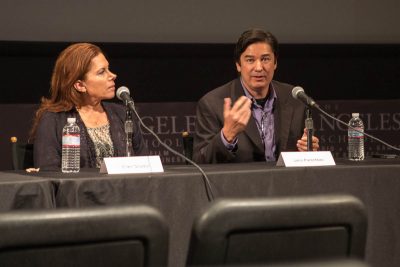
Ellen Shadur shared that “… my personal experience is that when employees go out and sign (union rep) cards saying that they want to be unionized, the employer brought it on themselves. There is something wrong, there is some manager, some problem.” This led to a discussion about films made that are non union, Kaplan said that the IA has negotiated with all levels of production, it’s not just one agreement fits all. They also recognize that union members may have to take non union work from time to time. Shadur cited examples where she has seen issues with union/non-union film work where rules designed to help have hurt adding “… my personal view is, unionization is not going to solve all the issues, obviously not having a union is creating problems and I think the best solutions are going to be somewhere in the middle, and not the same for every company”. Kaplan said he would like to review the specific examples she cited, adding “I don’t think the union is designed to solve all the problems, I think the union is designed to give the employees a voice in the workplace, and the employees are the ones who are the other half of the equation and without representation this issue becoming more and more exacerbated.”
Shindler asked about an example case of someone working in a union shop like Dreamworks but finds themselves moving on to a non union shop. Kaplan explained that they request members keep them informed of their movements and that in that situation they could be placed on “honorable withdrawal” with dues payment halted, do that job and notify the union when they return to a union job to return to active status.
Leverage
Leverage is a word that comes up frequently in union discussions, Kaplan explained some history from 1979 related to hand drawn animation – local 839 was able to strike and get language in the contract prohibiting runaway production, largely because they surprised the Producers with it. Three years later when the contract was up for renewal the Producers were prepared and that language was removed, they had lost the leverage. Kaplan: “…again the purpose of the union is to support the workers, it’s not to tell business how to run itself.” Shindler mentioned many of the vfx companies that have gone out of business, again returning to the lack of business experience of artist/owners and his experience as a business consultant at the lack of companies willing to really examine their situation. Asked if this fragility affects the timing of the organizing effort Kaplan responded: “…for a company in trouble, signing a union contract, could it help?, could it hurt?, I would argue help. I would also point out that the union is not interested in putting such weight on a contract that it would sink a company, that doesn’t benefit us or the workers that elected us as their representatives at all”. Bill Taylor added the applause line “…there is nothing the union can do that will offset boneheaded management decisions.”
Putting a sharp point on the discussion about the global nature of the business Shindler gave some stats on the growth of the Chinese film market and what he called the revenue shift. The studios used to derive 70% or more of their revenue in North America, that has now flipped where international box office now is responsible for 70% of the revenue. In 2011 China was #3 in box office, they are now #2 and by 2020 China will be the largest market in the world. Eight theaters open every day in China. Shindler: “China is going to need product, and with only 34 movies allowed into the country each year, up from 20 a year ago… they are going to need to fill seats with homegrown content. It’s obvious effects are going to need to be done there”.
Bill Taylor told of visiting a studio in Korea and finding the quality of the work was very high, “world class”. Two questions he was asked while he was there stood out to him “can you bring us work?” and “how can we work in the US?”. He had an opportunity to view some student work at a school there: “The quality internationally is going to get higher, it’s going to become very competitive with the best of the work being done here and that’s just a fact of life. At the same time this creates an economic pressure as people doing this work suddenly realize ‘I have a family to feed, I’ve got to try and improve my lot in life’, the thrill of doing visual effects work for $6 an hour when you are aware of what the standards are elsewhere, tends to pall after awhile.” Taylor said that in the long term he thinks this will benefit everyone as people realize “good work deserves respect”.
Ellen Shadur took that further: “This is still the place to be… Hollywood, Los Angeles, the United States… particularly for this industry, everyone wants to come here once, there is nothing like working in the industry and being in Hollywood.” She spoke of examples of partnerships between education, unions and companies to solve problems and even how unions have used lobbying power in other industries. Kaplan agreed and reiterated his support and mentioned the support he hears from visual effects artists for a Trade Association as well as an organized artists force – that is our best chance for significant change. Kaplan alluded to the struggle Scott Ross has faced in trying to engage visual effects companies about forming a Trade Association. Around this time a tweet went out from @DrScottRoss in the audience saying “Wishing I was on the panel!”. Ross did join in during the Q&A, more about that in a bit.
The Mechanics – how would a union be formed?
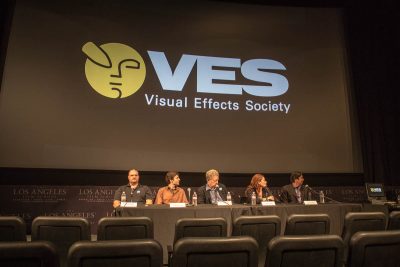
Shindler asked Kaplan to detail the path to unionizing. Kaplan: “…as I mentioned it has to start with those affected, artists working at a studio who feel they want representation would seek out information on the union. We would take meetings, we would have discussions, describe to them what a union is, what we are trying to accomplish, what could be written into a contract and what the process would be like. During those discussions we would say if you are interested and you feel comfortable, we need you to sign a ‘white card’, a representation card. These representation cards are physical manifestations or your intentions, meaning you the artists, your interest to be represented by a union. It’s not a promise to join, it carries no financial responsibility, it just says ‘I, Joe Artist, working at XYZ Studio, as a TD want to be represented by the union’.” Kaplan continued: “The law states that with 30% of support from the affected unit we could approach the National Labor Relations Board (NLRB) and petition for a representation election, which would appoint the union as the bargaining agent for that unit. 30% is a low number so the union tends to aim a little bit higher, like 65-70% typically would be comfortable.” “With that support the union would approach the employer and essentially knock on the door and say ‘hi, we’re the union, we’ve got a majority of support inside, would you voluntarily recognize us as the bargaining agent for this unit. Typically the employers say ‘No’ so we have we go to the NLRB and petition for an election.”
The election usually takes place in a few weeks, Kaplan explained that during that time the employer typically runs an anti union campaign, spreading information designed to discourage voting for the union. The union works hard to counter act that and knock down propaganda and then the election is held. If the vote goes in favor of the union then the employer is forced by law to sit and bargain “in good faith” with the union. Eventually a contract is drafted and sent to the workers to ratify, if they ratify it, it’s a union shop.
Question and Answer Time
There were a lot of people anxious to ask questions and a lot of the questions frankly, while valid, were things that could be answered with a little research on the internet. On the right hand panel next to this story you will find a “related links” box with links to much of the coverage we have done at fxguide including a podcast we did back in May with Peter Marley, International Representative for the IA. In that podcast Marley went into a lot of specifics on the mechanics on the organizing process, how temporary workers are counted, and a lot of information it would be hard to repeat here or for them to adequately cover in the limited time of this panel or Q&A.
Scott Ross, a Trade Association and a Change of Heart
Many in the room had been waiting for Scott Ross’s turn at the microphone. Ross has the unique status in the industry of having run two world class visual effects companies (ILM and Digital Domain, the latter he co-founded). Ross pointed out that ILM was a union shop when he ran it and Digital Domain was not. He has spoken out in previous interviews (see related links) and as recently as at the VES Summit that he did not think a union was a good idea at this time. Ross: “For a long time I was very, very against the union because it took the power out of management’s hands to do the things that we thought it might be necessary to do. And I’m the guy that Steve (Kaplan) has been talking about who for the last two years has been trying to put together a Trade Association… and let me tell you it’s impossible.” “I spoke with 15 visual effects companies CEO’s and managers, of those.. about 8 of them said they would be interested, but they were second tier companies. The big seven or ten were not interested.”
After talking about how the studios are making hundreds of millions of dollars on the backs of our work, while playing economic games to make films make no money on paper, Ross said: “I still think the Trade Association is the most critical path, because once we solve that and we start to get money coming back into the visual effects facilities, I believe that a lot of the woes that the visual effects worker faces will start to go away.” Ross went on to make a pretty significant announcement: “I have since changed my mind, the way I look at it now is, the visual effects studios, the management of these companies, will not go up against their client because of fear. With that fear we are going to continue to cycle down and it’s going to be a disaster. So my sense is that a visual effects union might force the visual effects facility owners and managers to actually come together and address the issues. So because of that, I’m supporting a visual effects union” (applause).
Summary
We found the event to be very open and a lot of information was presented, we wish there had been more time for Q&A.
There seemed to be very strong support for both the idea of a visual effects union and a Trade Association. We talked with some afterwards who said that we could easily see some movies missing release dates if the industry continues it’s current path. Some felt that may even be a good thing. In spite of all the issues the visual effects community faces the business is still filled with people who passionately love what they do. There is also concern among the artists about the decline of conditions for artists globally.
Going into the day we were concerned that the events of the last few months – bankruptcies, pay cuts and the like – would be the focus of the conversation. While these topics did come up, we did not feel they dominated the conversation. We sensed very little animosity from artists aimed at most visual effects companies. But… there does seem to be consensus that the visual effects business model is broken and that the artists have no control over that. Visual effects companies are finding themselves pushed to the limit and these problems are now more directly affecting artists. The result – accelerating conversations like those calling for unionization, bringing to the surface a movement that has been building steadily for many years.
We continue our bewilderment that the visual effects companies do not already have a global Trade Association and that there seems to be no path leading in that direction.
Information page for IATSE Visual Effects Union – vfx.iatse-intl.org
UPDATE December 5, 2102: VES has released videos of the event
PART 1: vimeo.com/54898430
PART 2: vimeo.com/54957963

“There were a lot of people anxious to ask questions and a lot of the questions frankly, while valid, were things that could be answered with a little research on the internet.”
Maybe the Internet can answer this one:
Suppose we don’t unionize and we don’t form a trade organization. In that scenario, how will the VFX industry attract *and keep* top talent as working conditions continue to decline?
I know VFX artists who have already left the VFX industry for better compensation elsewhere. Some teach VFX at schools. Some now create casino graphics in Las Vegas for an eight-hour day plus benefits. Some now work at Local 839 studios (ex: Disney, Dreamworks, Sony Animation) for three pensions + health insurance. Some create visualizations for government institutions and corporations. Some moved on to video game companies that offer health insurance, 401(k)s and profit sharing. Some formed their own businesses writing software. They didn’t like where the VFX industry was headed, so they left.
Great article Jeff. Thanks for the write up.
Maybe it’s the way I’m reading the summary but, after discussing the pros and cons of unionizing, it seems like the majority of folks were in agreement that a union is a good idea. Do you think that was the general sentiment after everything was said?
If so, did anyone propose any next steps for the near term? If we’re finally coming to a consensus, lets get this thing started.
Thanks again.
The overall mood of the room was very pro-union, at least that is me trying to judge from the crowd reactions during the event and talking to people before and after. I personally have attended about 10 meetings leading up to this, from bars to beaches, IATSE to IBEW.
IATSE announced their intention to organize Visual Effects publicly on 11/11/2010 (753 days ago).
http://www.fxguide.com/quicktakes/iatse-formally-announces-visual-effects-organizing-drive/
Leading up to that date there was about a years worth of secret meetings with key visual effects people gauging interest.
As far as the steps and getting started, it eventually comes down to individuals taking the next step, which is sending in a rep card.
Hi,
the link to the video with second part of the talk is broken.
Thanks for the interesting article.
Looks like a vimeo or VES problem, it was there when I posted and now is not listed under VES vimeo account
Ok thanks for the quick answer. I hope they will put it back soon.
It’s back 🙂
Thanks!
Seem that they removed the video from the public. It seems the video is password protected. I hope they fix that asap.
Indeed. The videos have been made private. That’s a shame.
Pingback: Understanding Unions: The Good, The Bad & Ugly - Thinking Animation
Pingback: Thinking Animation | Understanding Unions: The Good, The Bad & Ugly - Thinking Animation